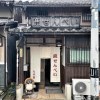
One simple chart could have made all the difference.
The average level of English capability in Japan is pretty low, despite the language being a required subject in schools starting from junior high. There are a number of possible reasons for this dichotomy, but Japanese Twitter user @Heehoo_kun has found what, for him, is the biggest.
英語でこれを教えないせいでどんだけ今まで無駄な時間を費やしてたのか pic.twitter.com/b6ihPbxoQf
— (っ╹◡╹c) (@Heehoo_kun) April 15, 2019
“We wasted so much time in English class,” tweeted @Heehoo_kun in exasperation, “because they didn’t teach us this.”
So what’s this missing piece of the English puzzle @Heehoo_kun says he was never given? Phonics. Specifically, he tweeted a page from a book showing a basic phonics pronunciation chart for each letter of the alphabet.
While phonics might seem like a practically self-explanatory concept to native English speakers, that’s often far from the case for Japanese learners of English, for a number of reasons. First off, in Japanese almost every consonant has to be connected to a vowel (aside from a small handful of exceptions like “n” and consonant blends “sh” and “ky,” and even the blends have to be followed immediately by a vowel). Because of that, there’s no indigenous Japanese concept that the letter b or t can have any sort of sound by itself.
▼ “What is the sound of one t existing?
The second problem is that in Japanese, even when using the phonetic scripts called hiragana and katakana, there’s no difference between the name of the character and the way it’s pronounced. For example, if you write “ramen” in Japanese, it’s ラーメン, and that first character, ラ, is both called and pronounced “ra.” Compare that to English, where the first letter in ramen, r, makes a “r-“ sound, but the name of the latter itself is pronounced like “ar.”
Combined, these two factors mean that when they’re reading Japanese, Japanese people largely string together pre-determined sets of characters, each of which they’ve already memorized the correct pronunciation for. Even when using non-phonetic kanji characters, words are made up of pre-set chunks, like with Tokyo, 東京, which a native Japanese reader’s brains parses by recognizing that 東 is “To” and 京 is “kyo.”
English, though, requires the complete opposite approach. The reader must stay patient and pronounce one letter at a time until the sounds eventually blend together to form the word. However, if teachers and texts don’t properly explain that, as seems to be what happened with @Heehoo_kun, English is going to feel like an arbitrary and intimidating mess of vocabulary words that have to be memorized in their entirety.
▼ Reading is a staccato process in Japanese, but a flowing one in English.
@Heehoo_kun says he found the phonics chart in a book from Japanese author Hiroshi Matsui titled One-Shot Understandable English Pronunciation for Japanese People (available on Amazon here), and a number of other Twitter users were equally impressed with its phonics chart, leaving comments such as:
“This is so true!!!!! When I was in the first year of junior high, I tried reading A, B, C, D as “ah, bu-, cu- du-,” and my teachers all told me I was wrong!!! My method was just too advanced for them.”
“I did the same thing, and my teacher got mad at me.”
“Schools don’t teach phonics because Japan is all about written tests for English.”
“I wanted a chart like that. I kept trying to tell my teacher I just couldn’t figure out how to read words in English, and this would have been such a big help.”
“I’m in high school now, and I don’t remember doing phonics in junior high.”
However, the quality of English instruction in Japan tends to vary widely depending on the specific instructor and institution, and a few other online commenters chimed in to say this wasn’t their first exposure to phonics.
“I think schools are required to teach this starting in junior high now.”
“They cover phonics in the English-learning programs on [public broadcaster] NHK.”
“I took after-school classes at an English conversation school starting in the third year of elementary school, and I learned phonics then.”
Still, @Heehoo_kun and others like him never got this critical English-learning tool, which is probably something important to keep in mind should you find yourself working in the English-teaching field in Japan, or otherwise trying to communicate with a Japanese person in English.
Source: Twitter/@Heehoo_kun via Jin
Top image: Pakutaso
Insert images: Pakutaso, SoraNews24
● Want to hear about SoraNews24’s latest articles as soon as they’re published? Follow us on Facebook and Twitter!
Follow Casey on Twitter, where he’s always up for some linguistics.



 Japanese elementary school student teaches us all how to pronounce English like a native speaker
Japanese elementary school student teaches us all how to pronounce English like a native speaker What’s wrong with English education in Japan? Pull up a chair…
What’s wrong with English education in Japan? Pull up a chair… Everyday Japanese names that make English speakers chuckle
Everyday Japanese names that make English speakers chuckle Japanese government to make first change to romanization spelling rules since the 1950s
Japanese government to make first change to romanization spelling rules since the 1950s When “yes” means “no” — The Japanese language quirk that trips English speakers up
When “yes” means “no” — The Japanese language quirk that trips English speakers up How to order snacks on a Shinkansen bullet train in Japan
How to order snacks on a Shinkansen bullet train in Japan Japan’s new difficult-to-drink-from beer glass protects your liver, but it’s a brutal experience
Japan’s new difficult-to-drink-from beer glass protects your liver, but it’s a brutal experience Demon Slayer: Kimetsu no Yaiba gets new roller coaster attractions and food at Universal Studios Japan
Demon Slayer: Kimetsu no Yaiba gets new roller coaster attractions and food at Universal Studios Japan Burger King Japan suddenly adds Dr. Pepper and Dr. Pepper floats to its menu nationwide
Burger King Japan suddenly adds Dr. Pepper and Dr. Pepper floats to its menu nationwide New Pokémon ice cream, dessert drinks, and cool merch coming to Baskin-Robbins Japan【Pics】
New Pokémon ice cream, dessert drinks, and cool merch coming to Baskin-Robbins Japan【Pics】 New Nintendo Lego kit is a beautiful piece of moving pixel art of Mario and Yoshi【Photos】
New Nintendo Lego kit is a beautiful piece of moving pixel art of Mario and Yoshi【Photos】 New samurai glasses are Japan’s latest weird must-have souvenir
New samurai glasses are Japan’s latest weird must-have souvenir Kyoto Tower mascot termination reveals dark side behind cute Japanese characters
Kyoto Tower mascot termination reveals dark side behind cute Japanese characters Hello, cosmetics! Clinique teams up with Hello Kitty this summer for first-time collaboration
Hello, cosmetics! Clinique teams up with Hello Kitty this summer for first-time collaboration This Nara workshop has been making deer crackers for more than 100 years and offers tours【Photos】
This Nara workshop has been making deer crackers for more than 100 years and offers tours【Photos】 Nintendo history you can feel – Super NES, N64, and GameCube controllers become capsule toys
Nintendo history you can feel – Super NES, N64, and GameCube controllers become capsule toys “The most Delicious Cup Noodle in history” – Japan’s French Cup Noodle wins our heart【Taste test】
“The most Delicious Cup Noodle in history” – Japan’s French Cup Noodle wins our heart【Taste test】 Starbucks releases a cute Frappuccino and Unicorn Cake…but not in Japan
Starbucks releases a cute Frappuccino and Unicorn Cake…but not in Japan McDonald’s Japan’s Soft Twist Tower: A phantom ice cream only sold at select branches
McDonald’s Japan’s Soft Twist Tower: A phantom ice cream only sold at select branches Yabai Ramen: What makes this Japanese ramen so dangerous?
Yabai Ramen: What makes this Japanese ramen so dangerous? Finally! Nintendo Japan expands Switch 8-bit controller sales to everybody, Online member or not
Finally! Nintendo Japan expands Switch 8-bit controller sales to everybody, Online member or not Japanese government wants to build luxury resorts in all national parks for foreign tourists
Japanese government wants to build luxury resorts in all national parks for foreign tourists To combat declining birth rate, Japan to begin offering “Breeding Visas” to foreigners
To combat declining birth rate, Japan to begin offering “Breeding Visas” to foreigners 10 things you should buy at 7-Eleven in Japan
10 things you should buy at 7-Eleven in Japan Studio Ghibli releases anime heroine cosplay dresses that are super comfy to wear
Studio Ghibli releases anime heroine cosplay dresses that are super comfy to wear Woman charged for driving suitcase without a license in Osaka
Woman charged for driving suitcase without a license in Osaka Studio Ghibli unveils My Neighbour Totoro miniature house model
Studio Ghibli unveils My Neighbour Totoro miniature house model Kyoto experiencing problems with foreign tourists not paying for bus fares, but not on purpose
Kyoto experiencing problems with foreign tourists not paying for bus fares, but not on purpose Fighting mild hunger with a Japanese soda that turns into jelly in the stomach【Taste test】
Fighting mild hunger with a Japanese soda that turns into jelly in the stomach【Taste test】 Studio Ghibli’s Howl’s Moving Castle tapestry unveiled in Japan for first time
Studio Ghibli’s Howl’s Moving Castle tapestry unveiled in Japan for first time McDonald’s new Happy Meals offer up cute and practical Sanrio lifestyle goods
McDonald’s new Happy Meals offer up cute and practical Sanrio lifestyle goods Sales of Japan’s most convenient train ticket/shopping payment cards suspended indefinitely
Sales of Japan’s most convenient train ticket/shopping payment cards suspended indefinitely Sold-out Studio Ghibli desktop humidifiers are back so Totoro can help you through the dry season
Sold-out Studio Ghibli desktop humidifiers are back so Totoro can help you through the dry season Japanese government to make first change to romanization spelling rules since the 1950s
Japanese government to make first change to romanization spelling rules since the 1950s Foreigner’s request for help in Tokyo makes us sad for the state of society
Foreigner’s request for help in Tokyo makes us sad for the state of society Ghibli founders Toshio Suzuki and Hayao Miyazaki contribute to Japanese whisky Totoro label design
Ghibli founders Toshio Suzuki and Hayao Miyazaki contribute to Japanese whisky Totoro label design Doraemon found buried at sea as scene from 1993 anime becomes real life【Photos】
Doraemon found buried at sea as scene from 1993 anime becomes real life【Photos】 Tokyo’s most famous Starbucks is closed
Tokyo’s most famous Starbucks is closed Princesses, fruits, and blacksmiths: Study reveals the 30 most unusual family names in Japan
Princesses, fruits, and blacksmiths: Study reveals the 30 most unusual family names in Japan The science behind why English speakers can’t pronounce the Japanese “fu”
The science behind why English speakers can’t pronounce the Japanese “fu” Seven mistakes foreigners make when speaking Japanese—and how to fix them
Seven mistakes foreigners make when speaking Japanese—and how to fix them English conversation school in Japan has clever reminder that students don’t have to be perfect
English conversation school in Japan has clever reminder that students don’t have to be perfect Here’s a funny anecdote about Japanese kindergartners (maybe) yelling “killing me” in unison
Here’s a funny anecdote about Japanese kindergartners (maybe) yelling “killing me” in unison English pick-up lines: Foreign writer shares his advice with amorous Japanese men
English pick-up lines: Foreign writer shares his advice with amorous Japanese men Under 35 percent of middle school English teachers in Japan meet government proficiency benchmark
Under 35 percent of middle school English teachers in Japan meet government proficiency benchmark Learn Japanese through ridiculous manga: Death Vote 【Episode #6】
Learn Japanese through ridiculous manga: Death Vote 【Episode #6】 Dark Horizon textbooks go beyond “Hello my name is…” to “Who are you calling a bitch, bitch!”
Dark Horizon textbooks go beyond “Hello my name is…” to “Who are you calling a bitch, bitch!” Foreign English teacher in Japan calls student’s ability garbage, says it was an “American joke”
Foreign English teacher in Japan calls student’s ability garbage, says it was an “American joke” The big biang theory! How the “most complicated” Chinese character keeps students from being late
The big biang theory! How the “most complicated” Chinese character keeps students from being late “Same sh*t different day” – Nice Japanese people swearing in English 【Video】
“Same sh*t different day” – Nice Japanese people swearing in English 【Video】 The Japanese you learn at school vs the Japanese used in Japan【Video】
The Japanese you learn at school vs the Japanese used in Japan【Video】 Nihon-no: Is an entirely English-speaking village coming to Tokyo?
Nihon-no: Is an entirely English-speaking village coming to Tokyo? RocketNews24’s six top tips for learning Japanese
RocketNews24’s six top tips for learning Japanese Researchers use uniformity of Japanese language to read people’s minds
Researchers use uniformity of Japanese language to read people’s minds Shibuya gives each public elementary and junior high student a Surface Go 2 tablet for school
Shibuya gives each public elementary and junior high student a Surface Go 2 tablet for school
Leave a Reply